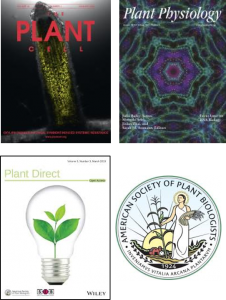Promoting the value of publishing in society journals: Perspective from ASPB
With the rise of high-impact commercially published journals in recent years, journals published by learned societies face greater competition than ever before. While many society journals are among the highest-impact titles in their fields, making them top choices among scholars, for societies it is becoming increasingly important to communicate the unique value of their titles beyond impact alone. Many society publishers have begun to place greater emphasis on promoting the connections between their publishing programs and wider initiatives to communicate to scholars how choosing to publish in and support society journals contributes to the advancement of their disciplines.
 “I can attest firsthand that scholars don’t always realize the benefits of publishing in their professional society’s journal,” said Nancy Winchester, Director of Publications at the American Society of Plant Biologists (ASPB). “After speaking with hundreds of scientists at meetings in the United States and in Europe over the years, I’ve found that while everyone is aware of our journals, not everyone is aware of the extent to which they contribute to the society’s wider efforts to advance plant biology.”
“I can attest firsthand that scholars don’t always realize the benefits of publishing in their professional society’s journal,” said Nancy Winchester, Director of Publications at the American Society of Plant Biologists (ASPB). “After speaking with hundreds of scientists at meetings in the United States and in Europe over the years, I’ve found that while everyone is aware of our journals, not everyone is aware of the extent to which they contribute to the society’s wider efforts to advance plant biology.”
In recent years, ASPB has worked to promote the added value of its society publishing program as well as the wider society publishing community, becoming a founding member of the Scientific Society Publisher Alliance (SSPA) launched in 2017. The initiative, started by Mark Johnston, Editor-in-Chief, Genetics, aims to raise awareness of the ways society journals serve their constituents and advance research “by scientists for science.”
Winchester said efforts like SSPA, intended to promote the added value of society journals, are not necessarily about trying to increase submissions. “ASPB’s journals are high impact and attract authors on their own, and the same goes for other SSPA publications,” she said. “The goal is rather to get the word out that when you publish with a society you support your professional community. ASPB, like any other society, does a lot for its discipline. We work with lobbyists on Capitol Hill, we have active educational outreach, we have an annual meeting, and so much more, and we want scholars to know all of this. Our goal is to continue to publish the top journals in plant biology. But what we also want to convey as a society publisher is a strong sense of service to our constituents.”
Raising awareness of the ways that ASPB journals contribute to the society mission has become an ongoing focus for the publishing team. “We are constantly working on education and outreach,” said Managing Editor Jennifer Regala, who leads ASPB’s journal promotion efforts.
Finding opportunities for cross-pollination at ASPB
For ASPB, one of the most promising outcomes of placing more emphasis on promoting the society-wide value of its journals has been greater collaboration between the ASPB publishing division and other departments. “One of our colleagues coined the term ‘cross-pollination’ and we really like that,” said Regala. “It’s been a concerted effort for us in Publications to work with others outside of our department to make sure we’re working together to amplify the messages of each ASPB department. The ideas generated have been really amazing.”
Regala gave the example of one cross-departmental collaboration called ASPB Journal Miles, a program the society launched to reward its journal reviewers. “You accrue ‘miles’ as a reviewer, basically like a point system,” Regala explained. “Reviewers can then redeem those miles for membership in ASPB. So it’s a way to both incentivize reviewers and encourage membership.”
Another area where ASPB’s publications team has been working more closely with other departments is planning for the society’s annual meeting. “This past year we worked to make sure the journals had a bigger presence in meeting planning,” said Regala. “We want to increase the visibility of our journals among members who maybe haven’t published with us yet, and to ensure that we’re communicating how the journals contribute to the society as a whole.”
Forging stronger connections with authors
In efforts to promote the value of ASPB’s journals individually and as part of wider society activity, ASPB’s publishing division has prioritized the experience of its authors. “We’re putting authors at the top,” said Winchester. “This past year we did a comprehensive author survey that was sent out to over 30,000 scholars actively publishing in our journals and others, informed beforehand by qualitative telephone interviews with about 30 individuals. Some of the questions focused on the advantages of publishing with your learned society instead of with a commercial journal. We were able to learn a lot about where there are gaps in awareness in terms of what the society does.”
Winchester and Regala said they’ve also expanded ASPB’s efforts to amplify the contributions of their journal authors within the wider plant biologist community. “We have active journal social media accounts, and we’ve been focused on promoting the journals from our society-level accounts as well, to reach people who might not be as entrenched in our publications world,” said Regala. “We do a lot of retweeting and conversing on an organization-wide ASPB level, and I think that has expanded our reach significantly.”
Ongoing engagement with the wider society and research community
In ASPB’s education and outreach, Winchester said the society is constantly focused on forging connections between its efforts and the wider plant biologist community. “Given that we are trying to advance plant biology for the benefit of all plant biologists and really humankind, we work very hard to establish relationships with our sister societies around the world,” said Winchester.
ASPB launched a global online plant community called Plantae to create a forum for plant scientists worldwide and is working to raise awareness of its publications within that forum. Regala said ASPB has been able to use Plantae’s blogging functionality to promote new journal articles. “For all of our journals, first authors of every research article we publish have the opportunity to write a profile that we then use as a blog post and share on social media to promote their research.”
Advancing the role of societies in the evolving publishing landscape
In terms of promoting the unique value of publishing in society journals across disciplines in the present and future publishing landscape, Winchester sees many opportunities. “I think new efforts are imperative, but the mechanisms exist to help even the smallest society journals stay relevant in their communities,” she said. “There are a lot of opportunities for advocating for our authors, our community, and our society while expanding our reach.”



